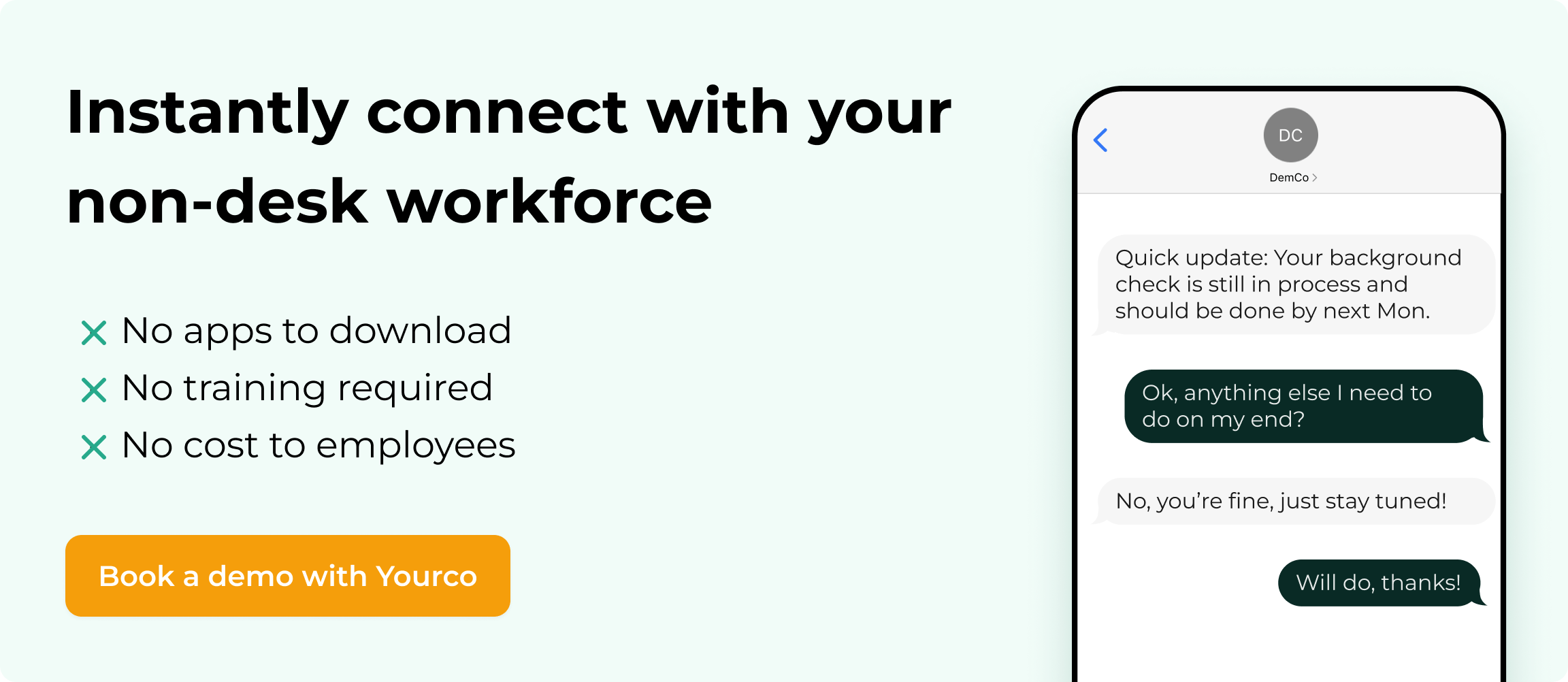Employee Exit Survey Questions to Help Reduce Turnover


Employee turnover can be a costly challenge for organizations. The expense of replacing a single employee often ranges from 50% to 200% of their annual salary, including recruiting, training, and indirect impacts like the impact on team productivity and morale. To address these issues effectively, companies need a clear understanding of why people leave.
Exit surveys offer a practical, consistent way to gather feedback from departing employees. When designed well, these surveys provide honest insights that help HR teams identify patterns across roles, departments, and tenure. They also promote data-driven decisions by moving beyond anecdotal feedback.
To help you build a more effective retention strategy, this article explores the most important employee exit survey questions, how to design them, and how to turn insights into action.
The Role of Employee Exit Survey Questions in Retention Strategies
Employee exit survey questions help organizations understand why employees leave and inform effective retention strategies. Unlike exit interviews, surveys capture standardized data points that allow for trend analysis over time. They also provide a degree of anonymity that encourages more honest responses from departing employees. This standardized approach enables organizations to identify patterns in why people leave and address systemic issues before they affect other employees.
Exit survey questions work effectively because:
- They provide a structured way to collect feedback consistently across all departing employees.
- The anonymity encourages more honest and detailed responses about sensitive issues.
- Data can be easily aggregated and analyzed to reveal trends over time or across departments.
- They allow for a mix of quantitative and qualitative questions, providing both measurable data and rich contextual insights.
Through exit survey data analysis, organizations can:
- Identify common reasons for turnover
- Uncover issues with specific managers or departments
- Gauge the effectiveness of company policies and practices
- Understand gaps in compensation, benefits, or career development opportunities
Exit survey questions also help organizations move beyond anecdotal evidence to data-driven decision-making.
Key Elements of Effective Employee Exit Survey Questions
When designing employee exit survey questions, several core elements contribute to their effectiveness in gathering valuable insights from departing employees. By focusing on these components, organizations can maximize the quality and usefulness of the feedback they receive.
Timing and Length
Timing significantly impacts response quality. Send surveys shortly after an employee gives notice but before their last day, while their experiences remain fresh yet emotions have balanced. Completion time should target 5-10 minutes maximum, as brevity encourages thoughtful responses and higher completion rates.
Long surveys lead to survey fatigue, resulting in rushed answers or abandonment. Consider your delivery method—SMS surveys should be shorter than email surveys. Some organizations find success with a two-stage approach: a short initial survey followed by an optional, more detailed questionnaire for those willing to provide additional feedback.
Testing different timing scenarios can help determine what works best for your organization's culture and employee demographics. Lastly, automated scheduling systems can ensure consistent timing across all departures.
Question Mix
A well-balanced exit survey incorporates various question types to capture comprehensive data. Using Likert scale questions to assess satisfaction with aspects of the job, work environment, and management. These quantitative measures should sit alongside open-ended questions that allow employees to voice concerns outside predefined options.
Multiple-choice questions provide structured data while matrix questions efficiently gather information on related topics. Rating scales offer nuanced measurement of satisfaction levels across different workplace factors.
The ideal mix typically includes 60-70% closed-ended questions for quantitative analysis and 30-40% open-ended questions for qualitative insights. This balance provides statistical trends while capturing the context and emotion behind the numbers, creating a fuller picture of employee experiences that lead to turnover decisions.
Anonymity Assurances
Confidentiality stands as a foundational element of effective exit surveys. Clearly communicate to departing employees exactly how their responses will be used, who will see them, and what anonymity protections exist. Employees provide more candid responses when their identity remains protected.
Consider implementing technical safeguards such as aggregating results from multiple respondents before reporting, removing identifying information from verbatim comments, and using third-party survey platforms that separate responses from employee identities. Let employees know whether their direct manager will see individual responses or only department-level summaries.
Some organizations find that having HR or an external consultant administer the survey increases trust in the process. The perception of confidentiality matters as much as the actual safeguards as if employees doubt their answers will remain private, they'll self-censor regardless of your policies.
Clear Communication About Data Usage
Transparency regarding how exit survey data will be utilized builds trust and improves response rates. Explain to participants exactly how their feedback contributes to organizational improvement, including specific examples of past changes made based on exit feedback. Detail which departments will receive the analysis, what level of detail will be shared, and the timeframe for implementing changes.
Address common concerns about whether responses might affect references or rehire eligibility. Organizations should create a standardized communication template explaining the survey purpose, anonymity protections, data security measures, and the feedback-to-action pipeline.
Consider sending a follow-up communication to all participants summarizing aggregated findings and actions taken, even after they've left the company. Announcing survey results demonstrates respect for their input and encourages positive word-of-mouth about your organization. Overall, being forthright about data usage shows departing employees that their experiences matter and reinforces a culture of continuous improvement.
Psychological Safety
Creating an environment of psychological safety proves essential for obtaining authentic feedback. This requires more than just policies—it demands cultural reinforcement throughout the employment lifecycle. Encourage honest communication by demonstrating receptiveness to constructive criticism during employment, not just at the exit stage.
Provide multiple feedback channels including anonymous options and third-party administration. Ensure survey questions avoid blame-oriented or defensive framing that might discourage honest responses. Train managers to receive feedback professionally without retaliation.
Consider allowing employees to select which parts of their feedback can be attributed versus anonymized. Some organizations find success with a graduated disclosure model where sensitive feedback gets anonymized while general observations can be attributed.
Document and communicate specific examples where exit feedback led to positive changes, reinforcing that honesty brings improvement rather than consequences. When employees feel protected in expressing their true thoughts, organizations gain invaluable insights that might otherwise remain hidden.
Balanced Data Collection
The most effective exit survey questions strike a balance between structured data collection and opportunities for open feedback. Structured questions with predefined response options facilitate quantitative analysis and trend identification, while open-ended questions allow employees to elaborate on their experiences.
This balanced approach enables organizations to identify what is happening and why it's happening. Consider implementing conditional logic that presents follow-up questions based on previous responses, diving deeper into specific issues without lengthening the survey for everyone.
For example, if an employee rates management poorly, present additional questions exploring that relationship. Strategic placement matters—position critical structured questions early in the survey and place open-ended questions strategically throughout, not just at the end.
Some organizations find that alternating between question types maintains engagement and yields more thoughtful responses. The goal is creating a complementary mix that provides statistical significance for decision-making and rich qualitative context that brings numbers to life.
Focus on Actionable Issues
Successful exit surveys concentrate on issues the organization can actually address, rather than gathering general opinions without practical application. Questions should uncover specific, actionable areas for improvement rather than vague dissatisfactions.
For example, instead of asking "Did you like working here?" ask "What specific company policies supported or hindered your productivity?" Focus on factors within the organization's control, such as management practices, compensation structures, career development opportunities, and work processes.
Include questions that distinguish between systemic issues affecting multiple employees versus individual circumstances. Consider categorizing questions by department responsibility to facilitate follow-up actions. Some organizations implement a priority rating system where departing employees indicate which issues most impacted their decision to leave.
This helps prioritize improvement efforts. Remember that actionable feedback requires appropriate specificity—too general and it lacks direction, too specific and it may compromise anonymity or apply to too few situations.
Tailoring Employee Exit Survey Questions for Maximum Impact
When crafting employee exit survey questions, it's important to develop a strategy that uncovers the true motivations behind employee departures. By carefully selecting question formats and content, you can gather rich, actionable insights to improve retention and workplace culture.
Crafting Questions That Uncover True Motivations
The key to effective exit surveys lies in using a mix of question types to capture quantitative data and qualitative insights. Here's how different formats impact the quality and usefulness of feedback:
- Open-ended questions: These allow employees to express their thoughts freely, often revealing unexpected insights and underlying issues. For example:
- "What were the main factors that influenced your decision to leave?"
- "How could we have improved your experience at our company?"
While open-ended questions provide rich detail, they can be time-consuming to analyze and may result in lower response rates due to the effort required.
- Likert scale questions: These quantifiable questions make it easy to track trends and compare data across departments or time periods. For instance:
- "On a scale of 1 to 5, how satisfied were you with your career growth opportunities?"
- "Rate your agreement with this statement: 'My manager provided regular, constructive feedback.'"
Likert scales offer quick insights but may lack context or nuance.
- Multiple-choice questions: These provide standardized, easy-to-analyze responses. For example:
- "Which of the following best describes your primary reason for leaving? (Compensation, Work-life Balance, Management, Career Growth, Other)"
While efficient, multiple-choice questions can be restrictive and may miss unique perspectives.
To maximize the impact of your exit survey questions, use a hybrid approach. Start with structured questions to collect baseline data, then use open-ended follow-ups to dive deeper into specific issues. This combination allows for both quantitative analysis and rich qualitative insights.
Exploring Sector-Specific Dynamics
When tailoring exit surveys for industries with high proportions of non-desk workers (e.g., manufacturing, construction, logistics), consider these sector-specific strategies:
- Focus on practical issues: Address concerns like shift scheduling, physical work environment, and safety practices.
- Use clear, concise language: Avoid jargon and complex phrasing that might be challenging for workers with varying education levels.
- Consider accessibility: Offer SMS-based survey options for employees without regular computer access.
- Explore team dynamics: In industries where teamwork is crucial, include questions about crew relationships and communication.
- Address industry-specific challenges: For example, in construction, you might ask about project completion stress or seasonal work concerns.
- Offer appropriate incentives: Consider incentives for non-desk workers to encourage participation and engagement.
Remember, the goal is to identify specific, actionable areas for improvement. Craft exit survey questions that will lead to concrete insights rather than vague issues. For instance, instead of asking, "Were you satisfied with your work environment?" try "What specific aspects of the work environment could be improved to make the job easier or more comfortable?"
Example Employee Exit Survey Questions
To gain valuable insights from departing employees, it's crucial to ask the right exit survey questions. Here are some effective examples organized by category:
Reasons for Leaving
- What is the primary reason for your decision to leave? (Multiple choice)
- Better compensation/benefits
- Career growth opportunities
- Work-life balance
- Company culture
- Management issues
- Other (please specify)
- Were there any secondary factors that influenced your decision? (Open-ended)
- On a scale of 1-5, how likely would you have been to stay if [factor mentioned] had been addressed?
Job Satisfaction and Career Growth
- How satisfied were you with your opportunities for professional growth? (1-5 Likert scale)
- Did you feel your work was valued and recognized? (Yes/No)
- What aspects of your job did you find most fulfilling? (Open-ended)
Work Environment and Culture
- How would you describe our company culture to a friend? (Open-ended)
- On a scale of 1-5, how well did the company's values align with your own?
- Did you feel included and respected in your work environment? (Yes/No/Sometimes)
Management and Leadership
- Did you receive adequate support from your supervisor? (1-5 Likert scale)
- How would you rate the effectiveness of communication from leadership? (1-5 Likert scale)
- What could your manager have done differently to improve your work experience? (Open-ended)
Recommendations for Improvement
- What changes would have made you consider staying with the company? (Open-ended)
- On a scale of 1-5, how likely are you to recommend our company as an employer to others?
- Is there anything else you'd like to share about your experience working here? (Open-ended)
Through consistently collecting and analyzing this data, organizations can identify trends, address issues proactively, and create a more engaging work environment that promotes higher retention rates.
Using Technology for Efficient Exit Survey Implementation
SMS-based platforms have emerged as a powerful tool for collecting timely and accurate feedback from departing staff. With a 98% open rate and most messages read within 3 minutes of receipt, SMS ensures that your exit survey questions reach employees quickly and effectively. This immediacy is particularly valuable for capturing honest feedback while the employee's experiences are still fresh in their mind.
For non-desk workers in industries like retail, manufacturing, or logistics, SMS surveys offer unparalleled accessibility. Unlike traditional email-based surveys, SMS doesn't require access to a company computer or email account, making it ideal for reaching employees who may not have regular desk time.
The convenience factor of SMS surveys can't be overstated. Employees can respond at their own pace, from anywhere, using their personal mobile devices. This flexibility often leads to higher response rates and more candid feedback, as employees feel less pressured and more comfortable sharing their thoughts.
Modern SMS survey platforms like Yourco offer several advantages that enhance the survey process:
- Automated distribution and reminders, ensuring consistent outreach to all departing employees.
- Real-time translations, making it easier to gather feedback from a diverse workforce.
- Simplified analysis tools that help HR teams quickly identify trends and actionable insights.
- Guarantee of anonymity ensuring workers feel more comfortable being honest.
Turn Employee Exit Survey Questions Into Your Strategic Advantage
Well-designed employee exit survey questions give organizations a critical window into the real reasons employees choose to leave. By combining quantitative data with open-ended feedback, companies can spot patterns, address systemic issues, and build a culture that retains top talent.
For teams with non-desk workers, collecting this feedback shouldn't be complicated. That's where Yourco stands out. With its SMS-based communication platform, employees can share their thoughts quickly and easily from any mobile phone, without needing to download an app or log into a system. Surveys are delivered instantly, responses are collected securely, and participation is seamless—even for teams working on factory floors, job sites, or out in the field.
Yourco’s built-in translations, custom groups, and HRIS integrations make it indispensable for organizations with diverse, distributed workforces. Every voice can be heard, and every response contributes to smarter retention strategies.
Try Yourco for free today or schedule a demo and see the difference the right workplace communication solution can make in your company.



